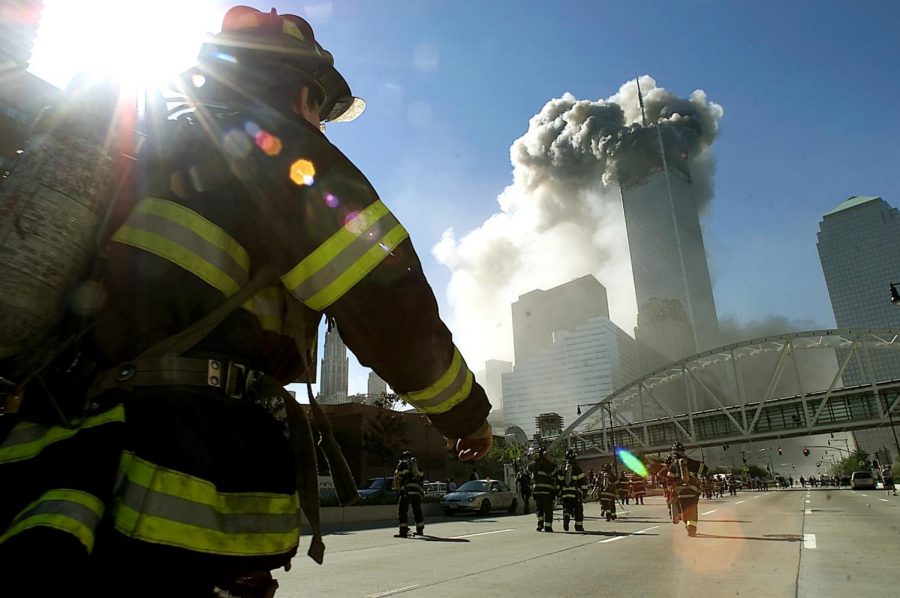We Will Never Forget
Jose Jimenez/ Primera Hora/ Getty Images
A photo of firefighters rushing towards the scene of the Twin Towers’ collapse, while dust and smoke clouds rise into the sky.
September 13, 2021
On September 11, 2001, the United States was shaken by a great catastrophe of death and destruction. This year on September 11, we mark the 20-year anniversary of the tragic events that occurred.
At 8:45 a.m. in New York City, civilians turned their heads to hear the roar of a Boeing 767 jet smash into the north tower of the World Trade Center. “The impact left a gaping, burning hole near the 80th floor of the 110-story skyscraper, instantly killing hundreds of people and trapping hundreds more in higher floors,” according to History on the Net.
Just 18 minutes after the first plane crash, a second Boeing 767 catapulted into the 60th floor of the south tower of the World Trade Center with similar results. America realized that these accidents were not by coincidence- they were being attacked.
Meanwhile, in Washington D.C. at the U.S. Department of Defence (also known as the Pentagon for its unique shape), American Airlines Flight 77 crashed into the structure. 125 people were killed inside the Pentagon, and 64 people were killed on the plane.
15 minutes after the Pentagon attack, the south tower of the World Trade Center collapsed and a monstrous cloud of smoke and dust billowed into the air. At 10:30 a.m., the north tower fell. Only six people total survived.
In rural Pennsylvania, United Flight 93 was hijacked and forcibly taken over. Fortunately, passengers were able to fight off the hijackers, but the plane went into a downward spiral at 500 miles per hour, hitting the ground and killing everyone on board. Although the original plane crash target was unknown, some suspect the White House, a presidential retreat called Camp David, or one of the nuclear power plants within the area.
At nine in the evening, U.S. President George W. Bush delivered a nationwide address broadcasted on television from the Oval Office in the White House. “Terrorist attacks can shake the foundations of our biggest buildings,” he announced, “but they cannot touch the foundation of America. These acts shatter steel, but they cannot dent the steel of American resolve.”
America responded to the terrorist attacks by rebuilding the damage that was done. Ruins from the World Trade Center towers and the Pentagon were cleared, and hospitals began to fill up with those wounded from the incidents. In addition, the U.S. Department of Homeland Security was created, a government office dedicated to “preventing terror attacks, border security, immigrations, and customs and disaster relief and prevention,” as stated by History on the Net.
“I remember where I was when I first saw [the attacks] on TV; I remember watching it and how it took over for so long,” reflects Ms. Miller, an eighth-grade teacher at McAuliffe. “There was no other conversation. [We] just kept watching it happening as things unfolded. And I remember that we had no idea who would do this to us. For me and my people, nobody had any idea.”
“It’s still so emotional,” Miller continues. “It was emotional then and still so emotional [today]. Stories about it, every anniversary, it’s incredibly emotional.”
On December 18, 2001, Congress named September 11 “Patriot Day”, in honor of those who served, survived and died. In 2009, Congress named that same day a National Day of Service and Remembrance. As a memorial for Patriot Day, two pools were dug into the ground and surrounded by cascading waterfalls. Surrounding the entire memorial are 152 bronze panels, with all the 9/11 victim’s names.
“9/11 should not be a symbol of sadness,” declares Joseph Pfeifer, who is considered to be the first Fire Department of New York chief to arrive on the scene of the World Trade Center attacks. “It should be a symbol of what we can do together, to help people in their greatest moment of need, no matter where that is.”



Braulio Leyva • Sep 19, 2021 at 1:16 pm
This is a great story!
Amelia Gutierrez • Sep 14, 2021 at 6:18 pm
Very interesting article!
Ms. Miller • Sep 13, 2021 at 11:32 am
Excellent article, Katie. A nice amount of information and I appreciate being interviewed for it. Nice Job!